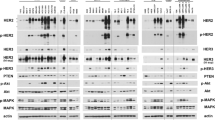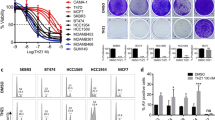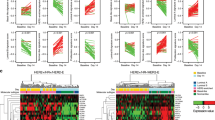Abstract
HER2/neu (HER2) and cyclin E are important prognostic indicators in breast cancer. As both are involved in cell cycle regulation we analyzed whether there was a direct interaction between the two. HER2 and cyclin E expression levels were determined in 395 breast cancer patients. Patients with HER2-overexpression and high levels of cyclin E had decreased 5-year disease-specific survival compared with low levels of cyclin E (14% versus 89%, P<0.0001). In vitro studies were performed in which HER2-mediated activity in HER2-overexpressing breast cancer cell lines was downregulated by transfection with HER2 small interfering RNA or treatment with trastuzumab. Cyclin E expression levels were determined by western blot analysis, and functional effects analyzed using kinase assays, MTT assays were used to assess cell viability as a marker of proliferation and fluorescence-activated cell sorting analysis was used to determine cell cycle profiles. Decreased HER2-mediated signaling resulted in decreased expression of cyclin E, particularly the low molecular weight (LMW) isoforms. Decreased HER2 and LMW cyclin E expression had functional consequences, including decreased cyclin E-associated kinase activity and decreased proliferation, because of increased apoptosis and an increased accumulation of cells in the G1 phase. In vivo studies performed in a HER2-overexpressing breast cancer xenograft model confirmed the effects of trastuzumab on cyclin E expression. Given the relationship between HER2 and cyclin E, in vitro clonogenic assays were performed to assess combination therapy targeting both proteins. Isobologram analysis showed a synergistic interaction between the two agents (trastuzumab targeting HER2 and roscovitine targeting cyclin E). Taken together, these studies show that HER2-mediated signaling effects LMW cyclin E expression, which in turn deregulates the cell cycle. LMW cyclin E has prognostic and predictive roles in HER2-overexpressing breast cancer, warranting further study of its potential as a therapeutic target.
This is a preview of subscription content, access via your institution
Access options
Subscribe to this journal
Receive 50 print issues and online access
$259.00 per year
only $5.18 per issue
Buy this article
- Purchase on Springer Link
- Instant access to full article PDF
Prices may be subject to local taxes which are calculated during checkout






Similar content being viewed by others
References
Akli S, Keyomarsi K . (2003). Cyclin E and its low molecular weight forms in human cancer and as targets for cancer therapy. Cancer Biol Ther 2: S38–S47.
Akli S, Van Pelt CS, Bui T, Multani AS, Chang S, Johnson D et al. (2007). Overexpression of the low molecular weight cyclin E in transgenic mice induces metastatic mammary carcinomas through the disruption of the ARF-p53 pathway. Cancer Res 67: 7212–7222.
Akli S, Zheng PJ, Multani AS, Wingate HF, Pathak S, Zhang N et al. (2004). Tumor-specific low molecular weight forms of cyclin E induce genomic instability and resistance to p21, p27, and antiestrogens in breast cancer. Cancer Res 64: 3198–3208.
Bacus SS, Stancovski I, Huberman E, Chin D, Hurwitz E, Mills GB et al. (1992). Tumor-inhibitory monoclonal antibodies to the HER-2/Neu receptor induce differentiation of human breast cancer cells. Cancer Res 52: 2580–2589.
Brockhoff G, Heckel B, Schmidt-Bruecken E, Plander M, Hofstaedter F, Vollmann A et al. (2007). Differential impact of cetuximab, pertuzumab and trastuzumab on BT474 and SK-BR-3 breast cancer cell proliferation. Cell Prolif 40: 488–507.
Buckley MF, Sweeney KJ, Hamilton JA, Sini RL, Manning DL, Nicholson RI et al. (1993). Expression and amplification of cyclin genes in human breast cancer. Oncogene 8: 2127–2133.
Cobleigh MA, Vogel CL, Tripathy D, Robert NJ, Scholl S, Fehrenbacher L et al. (1999). Multinational study of the efficacy and safety of humanized anti-HER2 monoclonal antibody in women who have HER2-overexpressing metastatic breast cancer that has progressed after chemotherapy for metastatic disease. J Clin Oncol 17: 2639–2648.
Dulic V, Drullinger LF, Lees E, Reed SI, Stein GH . (1993). Altered regulation of G1 cyclins in senescent human diploid fibroblasts: accumulation of inactive cyclin E-Cdk2 and cyclin D1-Cdk2 complexes. Proc Natl Acad Sci USA 90: 11034–11038.
Gusterson BA, Gelber RD, Goldhirsch A, Price KN, Save-Soderborgh J, Anbazhagan R et al. (1992). Prognostic importance of c-erbB-2 expression in breast cancer. International (Ludwig) breast cancer study group. J Clin Oncol 10: 1049–1056.
Harwell RM, Porter DC, Danes C, Keyomarsi K . (2000). Processing of cyclin E differs between normal and tumor breast cells. Cancer Res 60: 481–489.
Keyomarsi K, Herliczek TW . (1997). The role of cyclin E in cell proliferation, development and cancer. Prog Cell Cycle Res 3: 171–191.
Keyomarsi K, O′Leary N, Molnar G, Lees E, Fingert HJ, Pardee AB . (1994). Cyclin E, a potential prognostic marker for breast cancer. Cancer Res 54: 380–385.
Keyomarsi K, Pardee AB . (1993). Redundant cyclin overexpression and gene amplification in breast cancer cells. Proc Natl Acad Sci USA 90: 1112–1116.
Keyomarsi K, Tucker SL, Buchholz TA, Callister M, Ding Y, Hortobagyi GN et al. (2002). Cyclin E and survival in patients with breast cancer. N Engl J Med 347: 1566–1575.
Lambert LA, Qiao N, Hunt KK, Lambert DH, Mills GB, Meijer L et al. (2008). Autophagy: a novel mechanism of synergistic cytotoxicity between doxorubicin and roscovitine in a sarcoma model. Cancer Res 68: 7966–7974.
Le XF, Bedrosian I, Mao W, Murray M, Lu Z, Keyomarsi K et al. (2006). Anti-HER2 antibody trastuzumab inhibits CDK2-mediated NPAT and histone H4 expression via the PI3K pathway. Cell Cycle 5: 1654–1661.
Lee RJ, Albanese C, Fu M, D'Amico M, Lin B, Watanabe G et al. (2000). Cyclin D1 is required for transformation by activated Neu and is induced through an E2F-dependent signaling pathway. Mol Cell Biol 20: 672–683.
McCann AH, Dervan PA, O′Regan M, Codd MB, Gullick WJ, Tobin BM et al. (1991). Prognostic significance of c-erbB-2 and estrogen receptor status in human breast cancer. Cancer Res 51: 3296–3303.
Ohtsubo M, Roberts JM . (1993). Cyclin-dependent regulation of G1 in mammalian fibroblasts. Science 259: 1908–1912.
Ohtsubo M, Theodoras AM, Schumacher J, Roberts JM, Pagano M . (1995). Human cyclin E, a nuclear protein essential for the G1-to-S phase transition. Mol Cell Biol 15: 2612–2624.
Porter DC, Zhang N, Danes C, McGahren MJ, Harwell RM, Faruki S et al. (2001). Tumor specific proteolytic processing of cyclin E generates hyperactive lower-molecular-weight forms. Mol Cell Biol 21: 6254–6269.
Potemski P, Kusinska R, Watala C, Pluciennik E, Bednarek AK, Kordek R . (2006). Cyclin E expression in breast cancer correlates with negative steroid receptor status, HER2 expression, tumor grade and proliferation. J Exp Clin Cancer Res 25: 59–64.
Rao S, Lowe M, Herliczek TW, Keyomarsi K . (1998). Lovastatin mediated G1 arrest in normal and tumor breast cells is through inhibition of CDK2 activity and redistribution of p21 and p27, independent of p53. Oncogene 17: 2393–2402.
Roh H, Pippin J, Drebin JA . (2000). Down-regulation of HER2/neu expression induces apoptosis in human cancer cells that overexpress HER2/neu. Cancer Res 60: 560–565.
Slamon DJ, Clark GM, Wong SG, Levin WJ, Ullrich A, McGuire WL . (1987). Human breast cancer: correlation of relapse and survival with amplification of the HER-2/neu oncogene. Science 235: 177–182.
Slamon DJ, Godolphin W, Jones LA, Holt JA, Wong SG, Keith DE et al. (1989). Studies of the HER-2/neu proto-oncogene in human breast and ovarian cancer. Science 244: 707–712.
Spruck CH, Won KA, Reed SI . (1999). Deregulated cyclin E induces chromosome instability. Nature 401: 297–300.
Timms JF, White SL, O'Hare MJ, Waterfield MD . (2002). Effects of ErbB-2 overexpression on mitogenic signalling and cell cycle progression in human breast luminal epithelial cells. Oncogene 21: 6573–6586.
Vogel CL, Cobleigh MA, Tripathy D, Gutheil JC, Harris LN, Fehrenbacher L et al. (2002). Efficacy and safety of trastuzumab as a single agent in first-line treatment of HER2-overexpressing metastatic breast cancer. J Clin Oncol 20: 719–726.
Wingate H, Zhang N, McGarhen MJ, Bedrosian I, Harper JW, Keyomarsi K . (2005). The tumor-specific hyperactive forms of cyclin E are resistant to inhibition by p21 and p27. J Biol Chem 280: 15148–15157.
Wright C, Angus B, Nicholson S, Sainsbury JR, Cairns J, Gullick WJ et al. (1989). Expression of c-erbB-2 oncoprotein: a prognostic indicator in human breast cancer. Cancer Res 49: 2087–2090.
Yakes FM, Chinratanalab W, Ritter CA, King W, Seelig S, Arteaga CL . (2002). Herceptin-induced inhibition of phosphatidylinositol-3 kinase and Akt Is required for antibody-mediated effects on p27, cyclin D1, and antitumor action. Cancer Res 62: 4132–4141.
Yang HY, Zhou BP, Hung MC, Lee MH . (2000). Oncogenic signals of HER-2/neu in regulating the stability of the cyclin-dependent kinase inhibitor p27. J Biol Chem 275: 24735–24739.
Yarden Y, Sliwkowski MX . (2001). Untangling the ErbB signalling network. Nat Rev Mol Cell Biol 2: 127–137.
Yu D, Hung MC . (2000). Overexpression of ErbB2 in cancer and ErbB2-targeting strategies. Oncogene 19: 6115–6121.
Zhou BP, Liao Y, Xia W, Spohn B, Lee MH, Hung MC . (2001). Cytoplasmic localization of p21Cip1/WAF1 by Akt-induced phosphorylation in HER-2/neu-overexpressing cells. Nat Cell Biol 3: 245–252.
Acknowledgements
This work was supported by NIH T32 CA009599 (Mittendorf); AACR (Mittendorf); Susan G Komen for the Cure PDF0707621 (Keyomarsi and Mittendorf); Clayton Foundation for Research (Keyomarsi); NIH CA87458 (Keyomarsi); NCI P50CA116199 (Keyomarsi); Susan G Komen Breast Cancer Foundation BCTR0504200 (Hunt) and NIH 1K99CA133244-01 (Mittendorf).
Author information
Authors and Affiliations
Corresponding authors
Ethics declarations
Competing interests
Dr L Meijer is a coinventor on the patent on roscovitine licensed to Cyclacel.
Additional information
Supplementary Information accompanies the paper on the Oncogene website
Rights and permissions
About this article
Cite this article
Mittendorf, E., Liu, Y., Tucker, S. et al. A novel interaction between HER2/neu and cyclin E in breast cancer. Oncogene 29, 3896–3907 (2010). https://doi.org/10.1038/onc.2010.151
Received:
Revised:
Accepted:
Published:
Issue Date:
DOI: https://doi.org/10.1038/onc.2010.151
Keywords
This article is cited by
-
Combined treatment with anti-HER2/neu and anti-4-1BB monoclonal antibodies induces a synergistic antitumor effect but requires dose optimization to maintain immune memory for protection from lethal rechallenge
Cancer Immunology, Immunotherapy (2022)
-
Understanding and overcoming tumor heterogeneity in metastatic breast cancer treatment
Nature Cancer (2021)
-
Exosomes containing miRNAs targeting HER2 synthesis and engineered to adhere to HER2 on tumor cells surface exhibit enhanced antitumor activity
Journal of Nanobiotechnology (2020)
-
Targeting tumor cells with antibodies enhances anti-tumor immunity
Biophysics Reports (2018)
-
Cyclin E amplification, over-expression, and relapse-free survival in HER-2-positive primary breast cancer
Tumor Biology (2016)



